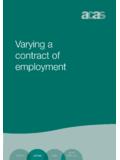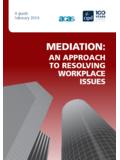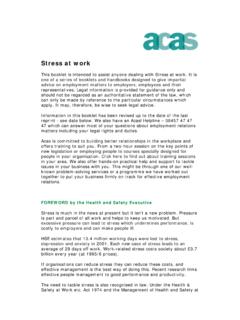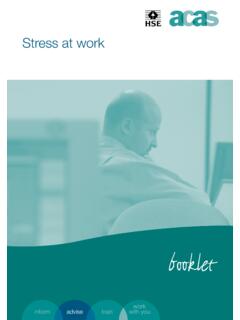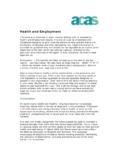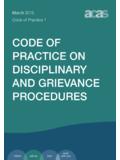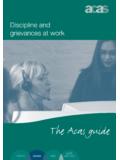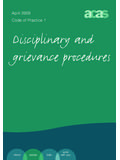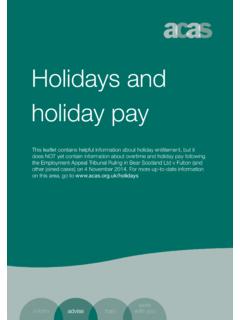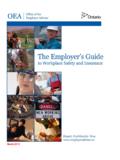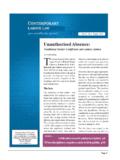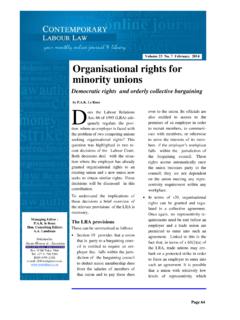Transcription of Age and the workplace - Acas
1 A guide for employers and employeesAge and the workplacePutting the Equality Act 2010 and the removal of the default retirement age (DRA) 2011 into practiceAcas can helpwith your employment relations needs Every year Acas helps employers and employees from thousands of workplaces. That means we keep right up to date with today s employment relations issues such as discipline and grievance handling, preventing discrimination and communicating effectively in workplaces. Make the most of our practical experience for your organisation find out what we can do for informWe answer your questions, give you the facts you need and talk through your options. You can then make informed decisions. Contact us to keep on top of what employment rights legislation means in practice before it gets on top of you. Call our helpline 0300 123 1100 or visit our website We advise and guideWe give you practical know-how on setting up and keeping good relations in your organisation.
2 Look at our publications on the website or ask our helpline to put you in touch with your local Acas adviser. Our Equality Direct helpline 0300 123 1150 advises on equality issues, such as discrimination. We trainFrom a two-hour session on the key points of new legislation or employing people to courses specially designed for people in your organisation, we offer training to suit you. Look on the website for what is coming up in your area and to book a place or talk to your local Acas office about our tailored work with youWe offer hands-on practical help and support to tackle issues in your business with you. This might be through one of our well-known problem-solving services. Or a programme we have worked out together to put your business firmly on track for effective employment relations. You will meet your Acas adviser and discuss exactly what is needed before giving any go-ahead. 1 ContentsIntroduction 2 Guidance for employers 3 What the Law says 3 age and the workplace some key management 9 considerations Managing your business needs and employee expectations 25 Monitoring age in your workplace 27 Objective justifications, exceptions, exemptions and 29 occupational requirementsGuidance for the Individual 35 What do I do if I think I have suffered discrimination 35 or harassment?
3 Annexes 38 Annex 1: An age healthcheck for employers 38 Annex 2: workplace discussions points to consider 39 Annex 3: Practical impact assessing for age bias in policies 41 Annex 4: Age monitoring a framework 42 Acas Training 43 Acas Publications 44 CONTENTSAGE AND THE WORKPLACE2 IntroductionFairness at work and good job performance go hand in hand. Tackling discrimination helps to attract, motivate and retain staff and enhances your reputation as an employer. Eliminating discrimination helps everyone to have an equal opportunity to work and to develop their skills. Terms in this guide workers and employees Workers are covered in the Equality Act and in this guidance. Workers often undertake roles similar to employees but do not have contracts of employment like employees, these include office holders, police, barristers and partners in a business. Our guidance uses the term employee throughout to cover all workers except under length of service issues which are for a narrower range of FOR EMPLOYERSG uidance for employers What the Law says In summaryIt is unlawful because of age to.
4 Discriminate directly against anyone that is, to treat them less favourably than others because of their actual or perceived age, or because they associate with someone of a particular age unless it can be objectively justified discriminate indirectly against anyone that is, to apply a criterion, provision or practice which disadvantages people of a particular age unless it can be objectively justified subject someone to harassment related to age victimise someone because they have made or intend to make a complaint or allegation or have given or intend to give evidence in relation to a complaint of discrimination because of age discriminate against someone, in certain circumstances, after the working relationship has ended, unless objectively justified compulsorily retire an employee unless it can be objectively AND THE WORKPLACE4 Direct discriminationDirect discrimination means that employees or job applicants are treated less favourably because of their actual or perceived age or because they associate with someone of a particular age.
5 For example it is unlawful to: decide not to employ someone dismiss them refuse to provide them with training deny them promotion give them adverse terms and conditionsbecause of their age, unless that treatment is objectively : Whilst being interviewed, a job applicant says that she took her professional qualification thirty years ago. Although she has all the skills and competences required of the job holder, the organisation decides not to offer her the job because of her age. This is direct : A job applicant can make a discrimination claim that may result in an employment discriminationIndirect discrimination means selection criteria, policies, benefits, employment rules or any other practices which, although they are applied to all employees, have the effect of disadvantaging people of a particular age unless the practice can be objectively justified. Indirect discrimination is unlawful whether it is intentional or discriminationThere are limited circumstances when it is lawful to treat people differently because of their age.
6 It is not unlawful to discriminate on the grounds of age if: t here is an objective justification for treating people differently for example, it might be necessary to fix a maximum age for the 5 WHAT THE LAW SAYS SUMMARY recruitment or promotion of employees (this maximum age might reflect the training requirements of the post). Such objective justification must however be proportionate and in response to a legitimate need (see page 35) t he discrimination is covered by one of the exceptions or exemptions for example pay related to the National Minimum Wage t here is an occupational requirement (OR) that a person must be of a certain age for example, if you are producing a play which has parts for older or younger more details see the section Objective justifications, exceptions, exemptions and occupational requirements on page is unwanted conduct related to a relevant protected characteristic, such as age, which has the purpose or effect of violating an individual s dignity or creating an intimidating, hostile, degrading, humiliating or offensive environment for that may be intentional bullying which is obvious or violent, but it can also be unintentional, subtle and insidious.
7 It may involve nicknames, teasing, name calling or other behaviour which is not with malicious intent but which is upsetting. It may be about the individual s age (real or perceived) or it may be about the age (real or perceived) of those with whom the individual associates. It may not be targeted at an individual(s) but consist of a general culture which, for instance, appears to tolerate the telling of age-related : A young employee is continually told he is wet behind the ears and straight out of the pram which he finds humiliating and distressing. This is AND THE WORKPLACE6 Example: An employee has a father working in the same workplace . People in the workplace often tell jokes about old fogies and tease the employee about teaching an old dog new tricks . This may be harassment because of age, even though it is not the victim s own age that is the subject of the harassing behaviour may not always be overtly related to age. For example, an individual could be ostracised or excluded by colleagues because of their may be able to claim harassment in circumstances where the unwanted behaviour is not directed at them, but at a colleague for example, if they can demonstrate that it created an offensive environment for them.
8 The complainant need not have the same age as the person who is being : Julie is in her late sixties and is claiming harassment against her line manager after he frequently teased and humiliated her about her age. Caroline shares an office with Julie and she too is claiming harassment, even though she is in her thirties, as the manager s behaviour has also created an offensive environment for may be held responsible for the actions of your staff as well as the staff being individually responsible. If harassment takes place in the workplace or at a time and place associated with the workplace , for example a work related social gathering, you may be liable and may be ordered to pay compensation unless it can be shown that you took reasonable steps to prevent harassment. Individuals who harass may also be ordered to pay at work by othersAn employee can make a complaint against their employer where they are harassed by someone who doesn t work for that employer such as a customer, client or passenger.
9 As an employer, once you are aware of this unwanted behaviour you should take reasonable and proportionate action to address the : Paul runs a coach company and one of his drivers Jack, who is in his forties but looks like a man in his early twenties tells him that he is feeling very distressed after regular passengers from a football team poke fun at him about his perceived age, calling him laddie and asking if he is old enough to have a driving licence. This isn t the first time this has happened and Jack says that this name calling is affecting his confidence as a driver. Paul reacts by having a word with the manager of the football team asking them not to talk to the driver in this fashion and making it clear that forms of harassment like this will not be tolerated on his coaches. Paul keeps Jack in the picture with what he has done and believes he is taking reasonable steps to protect should develop a reporting procedure for harassment, and should make all staff aware of the process for reporting an incident.
10 You should also ensure that you put processes in place to manage customers who behave in an offensive way. You may wish to consider placing signs on your premises or website stating that harassment of staff will not be tolerated. Handouts to workers visiting your premises could include a summary of your Equality Policy, as well as the more usual health and safety THE LAW SAYS SUMMARY AGE AND THE WORKPLACE8 VictimisationVictimisation is when an individual is treated detrimentally because they have made a complaint or intend to make a complaint about discrimination or harassment or have given evidence or intend to give evidence relating to a complaint about discrimination or may become labelled troublemaker , denied promotion or training, or be sent to Coventry by their colleagues. If this happens and if you fail to take reasonable steps to prevent it from happening, you may be ordered to pay compensation. Individuals who victimise may also be ordered to pay : An employee claims discrimination against their employer because of age.
